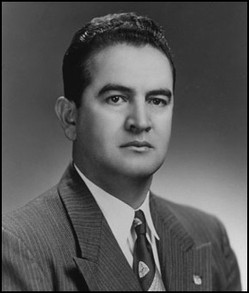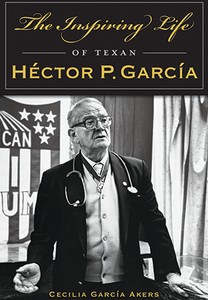Statue of Dr. Hector P. Garcia
Introduction
Text-to-speech Audio
This is the location of the statue of Dr. Hector P. Garcia, founder of the American G.I. Forum. Dr. Garcia, a former physician and WWII veteran dedicated much of his life to the struggle for equal rights Americans of Mexican heritage. He was especially active in promoting education and equal access to medical care. When he came back from the war, he established the American G.I. Forum, as a way to help Hispanics fight for and get the rights that they should have been getting. Through their efforts, they greatly changed how Hispanics got health care, treatment, and education, as well as becoming a well known consultant to the presidents of the united states on issues of civil rights.
Images
Picture of Dr. Hector P. Garcia

Current logo of the American G.I. Forum

Picture of Felix Longoria. The Longoria Affair was the case that catupulted the American G.I. Forum into the main stream.

Statue of Dr. Hector P. Garcia at the Mary and Jeff Bell Library at TAMUCC.

Learn more about Garcia with this book from The History Press

Backstory and Context
Text-to-speech Audio
Hector P. Garcia was born January 17, 1914 in Tamaulipas, Mexico. During the Mexican Revolution, his family fled from the violence and legally immigrated to Mercedes, Texas. Hector went on to earn his doctorate in medicine at the University of Galveston in 1940, and finished his residency at St. Josephs Hospital in Omaha Nebraska in 1942.
In 1942, Dr. Hector P. Garcia was called into active duty for the army during WWII. Originally put in charge of a branch of infantry in Europe, he was eventually transferred to the medical branch, where he went to rise to become a highly decorated Major. While stationed in Italy, he met Wanda Fusillo, with whom he was smitten with, and they married in 1945. At the end of the war, he and his wife moved back to Texas, settling down in the city of Corpus Christi.
With the war over, Garcia starting fighting for the rights of Hispanic American citizens. In 1948, he founded the American G.I Forum, which tackled the issues of civil rights for Hispanic Americans that were being neglected or oppressed. One of their first big cases was the Felix Longoria Affair, where a the widow of a deceased WWII veteran was denied the use of a local funeral home in Three Rivers, TX because they were Hispanic. Dr. Garcia and the G.I. Forum were reached for help in this matter, with Garcia going all the way to Senator Lyndon B. Johnson for help on this issue. Sen. Johnson responded by saying he had no authority over civilian funeral homes, but did offer to have Longoria's remains moved to Arlen National cemetery, and commented on how he was shocked that racism still extended even into death. This was the case that put the American G.I. Forum on the map.
Another issue that Garcia and the G.I. Forum wanted to tackle was the education system for Hispanic children. Garcia feared that children of his patients were not getting the proper resources and education that they deserved, and decided to stage his own investigation into the matter. He went through the schools of Corpus Christi, and found that the restrooms were dirty, fountains were not maintained, buildings were run down, and classrooms were overcrowded. In 1949, the G.I. Forum convention moved to have funding cut to schools that still practiced segregation, and that investigations be held in many of these school districts. CCISD was not very fond of this, but in February of 1966, they opened up a new high school in the district, which was Foy H. Moody High School. However, Black and Hispanic leaders complained about the boundary lines being drawn out for the new school, noting the fact that it was heavily segregated. CCISD denied any act of discrimination with the boundary line, even though further analysis of the practices found that it was in fact violating the Civil Rights Act of 1964. In 1977, Dr. Garcia and a group of students initiated a sit in at the CCISD offices, which led to the arrest of Dr. Garcia, which got him the attention he was looking for from the public and the media. After years of fighting and legal battles, the district enacted a new policy, finally ending the segregation in the schools. The G.I Forum went on to make sure that the Texas school districts would offer equal education to all of their students, and would attempt end the segregation of the public school systems.
Dr. Hector P. Garcia died on July 26, 1996 in Corpus Christi, TX, just shortly after this dedication at the Mary and Jeff Bell Library was opened in his honor. To this day, his legacy still goes on, with the American G.I. Forum still fighting to end segregation and give the help that people deserve it. This statue is only a small token to his memory, and all of the accomplishments he and the forum made in helping out the Hispanic nation in Corpus Christi and throughout the U.S.
In 1942, Dr. Hector P. Garcia was called into active duty for the army during WWII. Originally put in charge of a branch of infantry in Europe, he was eventually transferred to the medical branch, where he went to rise to become a highly decorated Major. While stationed in Italy, he met Wanda Fusillo, with whom he was smitten with, and they married in 1945. At the end of the war, he and his wife moved back to Texas, settling down in the city of Corpus Christi.
With the war over, Garcia starting fighting for the rights of Hispanic American citizens. In 1948, he founded the American G.I Forum, which tackled the issues of civil rights for Hispanic Americans that were being neglected or oppressed. One of their first big cases was the Felix Longoria Affair, where a the widow of a deceased WWII veteran was denied the use of a local funeral home in Three Rivers, TX because they were Hispanic. Dr. Garcia and the G.I. Forum were reached for help in this matter, with Garcia going all the way to Senator Lyndon B. Johnson for help on this issue. Sen. Johnson responded by saying he had no authority over civilian funeral homes, but did offer to have Longoria's remains moved to Arlen National cemetery, and commented on how he was shocked that racism still extended even into death. This was the case that put the American G.I. Forum on the map.
Another issue that Garcia and the G.I. Forum wanted to tackle was the education system for Hispanic children. Garcia feared that children of his patients were not getting the proper resources and education that they deserved, and decided to stage his own investigation into the matter. He went through the schools of Corpus Christi, and found that the restrooms were dirty, fountains were not maintained, buildings were run down, and classrooms were overcrowded. In 1949, the G.I. Forum convention moved to have funding cut to schools that still practiced segregation, and that investigations be held in many of these school districts. CCISD was not very fond of this, but in February of 1966, they opened up a new high school in the district, which was Foy H. Moody High School. However, Black and Hispanic leaders complained about the boundary lines being drawn out for the new school, noting the fact that it was heavily segregated. CCISD denied any act of discrimination with the boundary line, even though further analysis of the practices found that it was in fact violating the Civil Rights Act of 1964. In 1977, Dr. Garcia and a group of students initiated a sit in at the CCISD offices, which led to the arrest of Dr. Garcia, which got him the attention he was looking for from the public and the media. After years of fighting and legal battles, the district enacted a new policy, finally ending the segregation in the schools. The G.I Forum went on to make sure that the Texas school districts would offer equal education to all of their students, and would attempt end the segregation of the public school systems.
Dr. Hector P. Garcia died on July 26, 1996 in Corpus Christi, TX, just shortly after this dedication at the Mary and Jeff Bell Library was opened in his honor. To this day, his legacy still goes on, with the American G.I. Forum still fighting to end segregation and give the help that people deserve it. This statue is only a small token to his memory, and all of the accomplishments he and the forum made in helping out the Hispanic nation in Corpus Christi and throughout the U.S.
Sources
Saavedra, Rebecca. Hector P. Garcia: A Texas Legend. The University of Texas Medical Branch. Accessed November 28, 2016. https://www.utmb.edu/drgarcia/default.htm.
Akers, Cecilia G.. The Ispiring Life of Texan Hector P. Garcia. The History Press: Charleston, SC. 2016.
Allsup, Vernon C. The American G.I. Forum: Origins and Evolutions. Austin, TX. Austin: Center for Mexican American Studies, 1982.
Akers, Cecilia G.. The Ispiring Life of Texan Hector P. Garcia. The History Press: Charleston, SC. 2016.
Allsup, Vernon C. The American G.I. Forum: Origins and Evolutions. Austin, TX. Austin: Center for Mexican American Studies, 1982.
